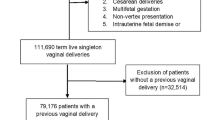Abstract
The objective of this study was to identify the rate of anal sphincter lacerations in a large population-based database and analyze risk factors associated with this condition. Data were obtained from Pennsylvania Healthcare Cost Containment Council (PHC4) regarding all cases of obstetrical third and fourth degree perineal lacerations that occurred during a 2-year period from January 1990 to December 1991. Modifiable risk factors associated with this condition were analyzed, specifically episiotomy, forceps-assisted vaginal delivery, forceps with episiotomy, vacuum-assisted vaginal delivery, and vacuum with episiotomy. There were a total of 168,337 deliveries in 1990 and 165,051 deliveries in 1991 in Pennsylvania. Twenty-two percent (n=74,881) of the deliveries were by cesarean section and were excluded from analysis. Among the remaining 258,507 deliveries, there were 18,888 (7.3%) third and fourth degree lacerations. Instrumental vaginal delivery, particularly with use of episiotomy, increased the risk of laceration significantly [forceps odds ratio (OR): 3.84, forceps with episiotomy OR: 3.89, vacuum OR: 2.58, vacuum with episiotomy OR: 2.93]. Episiotomy on the whole was associated with a threefold increase in the risk of sphincter tears. However, episiotomy in the absence of instrumental delivery seems to be protective with an OR of 0.9 [95% confidence interval (CI): 0.88–0.93]. Instrumental vaginal delivery, particularly forceps delivery, appears to be an important risk factor for anal sphincter tears. The risk previously attributed to episiotomy is probably due to its association with instrumental vaginal delivery. Forceps delivery is associated with higher occurrence of anal sphincter injury compared to vacuum delivery.


Similar content being viewed by others
References
1. Nationwide Inpatient Sample (NIS); URL: http://hcup.ahrq.gov/HCUPnet.asp
Haadem K, Dahlstrom JA, Ling L, Ohrlander S (1987) Anal sphincter function after delivery rupture. Obstet Gynecol 70:53–56
Haadem K, Ohrlander S, Lingman G (1988) Long-term ailments due to anal sphincter rupture caused by delivery—a hidden problem. Eur J Obstet Gynecol Reprod Biol 27:27–32
de Leeuw JW, Struijk PC, Vierhout ME, Wallenburg HC (2001) Risk factors for third degree perineal ruptures during delivery. BJOG 108:383–387
Handa VL, Danielsen BH, Gilbert WM (2001) Obstetric anal sphincter lacerations. Obstet Gynecol 98:225–230
Shiono P, Klebanoff MA, Carey JC (1990) Midline episiotomies: more harm than good? Obstet Gynecol 75:765–770
Curtin SC, Martin JA (2000) Births: preliminary data for 1999. Natl Vital Stat Rep 48:1–20
Eason E, Labrecque M, Wells G, Feldman P (2000) Preventing perineal trauma during childbirth: a systematic review. Obstet Gynecol 95:464–471
Author information
Authors and Affiliations
Corresponding author
Rights and permissions
About this article
Cite this article
Dandolu, V., Chatwani, A., Harmanli, O. et al. Risk factors for obstetrical anal sphincter lacerations. Int Urogynecol J 16, 304–307 (2005). https://doi.org/10.1007/s00192-005-1297-2
Received:
Accepted:
Published:
Issue Date:
DOI: https://doi.org/10.1007/s00192-005-1297-2




